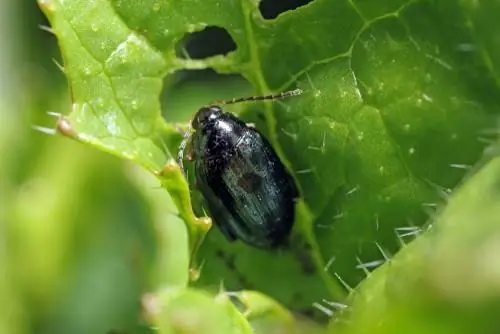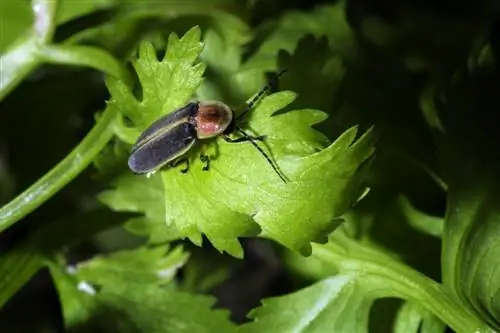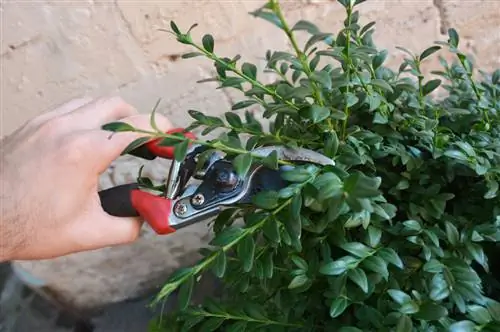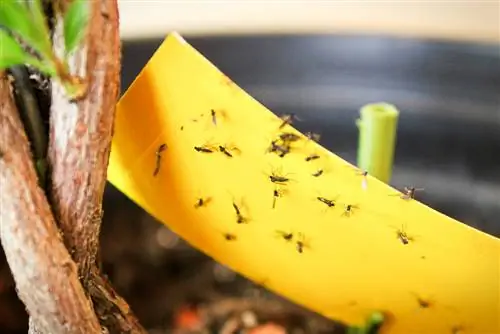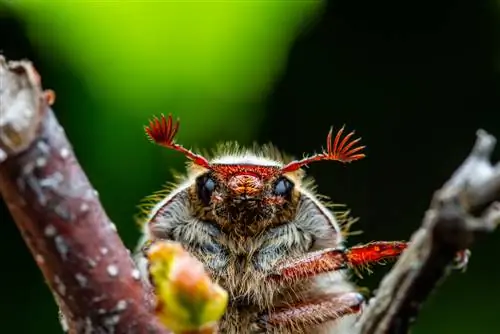- Author admin [email protected].
- Public 2023-12-26 14:17.
- Last modified 2025-06-01 06:02.
Almost every gardener knows the annoying, itchy bites of flea beetles that come after working in the vegetable patch. However, the little animals are even worse for many vegetable and ornamental plants, because their appetite for fresh, juicy leafy greens is huge. Typical signs of an infestation are pitting in the leaves, and vegetables and flowers also grow slowly. Fortunately, flea beetles can be easily combated or even prevented in the first place using non-toxic, simple measures - here we'll tell you how this works best.

Fight beetles effectively
Especially in spring, you should keep a close eye on your seedlings and young plants and regularly check them for flea beetle infestations - a quick reaction is important at this time in order to save the plants. Later in the year, the main aim is to prevent the larvae from pupating and the adult beetles from overwintering. To do this, it makes sense to regularly loosen the soil in the vegetable bed, remove weeds and keep the soil slightly moist - but definitely not wet! - to keep. The measures described below also help.
Especially in the garden, the principle “a lot helps a lot” does much more harm than good.
glue strips
This simple remedy is quite effective in controlling adult flea beetles, but must be used repeatedly throughout the growing season. Buy a bucket of caterpillar glue from a gardening store, apply it to several wooden boards and place them at regular intervals between the vegetable plants. The flea beetles jump on it when there is a disturbance, stay stuck and can ultimately be collected and disposed of along with the boards.
Natural enemies
The preferred hiding places of flea beetles (genus “Phyllotreta”), such as piles of leaves and wood, also attract many animal garden helpers, for whom the small beetles, their larvae and other pests are on the menu. Bring these beneficial insects into the garden in a targeted manner (some insects can be purchased from specialist retailers, for example) and create pleasant habitats for the animals, such as hiding places or a conveniently positioned insect hotel.
These animals are after the flea beetles:
- Hedgehog
- Shrew
- ground beetles
- Predator Beetle
- Parasitic wasp
Attractive plants
Also quite simple and easy to implement is a decoy plant that is planted in the middle of the bed and is intended to keep the flea beetles away from the other plants. Use a type of plant that is particularly popular with animals - for example broccoli or radish - which should be slightly larger than the other bed residents. Plant them in the bed together with their pot so that you can dispose of the eggs and larvae later. In contrast to the other bedding plants, keep the attractant plant dry and do not chop it. Once the beetles have settled on it, on a hot, dry day, wrap the plant in a plastic bag and remove it from the bed. But don't wait too long, otherwise the animals will look for another food plant.
How to recognize flea beetles early on
Due to their small size, only up to four millimeters long, adult flea beetles are difficult to recognize. However, the animals leave a characteristic damage pattern on the leaves and stems of the eaten plants, which makes them easy to recognize. The leaf surfaces are covered with numerous round, tiny holes. These are usually smaller than four millimeters. The greatest damage occurs when overwintering flea beetles attack young plants in large numbers between April and May and literally eat them away. The long hind legs of flea beetles are characteristic.
Dear fleas! Please be so kind and take advantage of the rain. Swimming is very he althy, if you could do a few hundred meters that would be great. I'm keeping my fingers crossed for you ✊ Then we'll be able to spoil our customers again soon with broccoli, carfiol, cabbage, kohlrabi and rucola. We will definitely see each other again, until then I wish you a wonderful summer? Your Meindlhof
A post shared by Meindlhof - naturally vegetables (@meindlhof_natuerlichgemuese) on Jul 7, 2019 at 2:21am PDT
Tip
A flea beetle infestation should also be combated because the feeding sites on the leaves and other plant parts serve as entry points for certain fungi, such as those from the Phoma genus, and thus cause additional damage through a fungicidal infection.
Which plant species are most affected?
Due to the wide distribution of the rapeseed flea beetle, plant species from the cruciferous family (bot. Brassicaceae) are particularly severely affected in the garden. This plant family includes numerous important vegetable and ornamental plants, as the following table shows:
| Vegetable plants | Ornamental plants |
|---|---|
| Radish, rocket, broccoli, kohlrabi, white and red cabbage, cauliflower, radish, Chinese cabbage, bok choy, tomatoes, potatoes, peppers | Levkoje, gold lacquer, night violet, blue cushions |
Not only cruciferous vegetables are affected, other plant species are also affected. For example, flea beetles can often be found on basil or hollyhocks. As a rule, flea beetles only feed on the leaves of plants, but in rare cases the tubers in the soil can also be affected. For example, the larvae also find radishes, which are often sown early in the year, very tasty.
Prevention is better than fighting
Effectively preventing an infestation with flea beetles is actually not that difficult - although it does take some effort. At best, you deprive the animals of their livelihood and ensure that the conditions favorable for their occurrence do not exist in the first place. You have to know that the leaf beetles mainly appear in warm and dry weather - and also attach great importance to peace and quiet.
An infestation can be significantly reduced or even completely prevented if you just regularly chop through the vegetable patch, pull out weeds and disturb the animals with this work. They quickly look for a quieter environment. Furthermore, you should keep the soil moist by watering and/or spraying regularly - of course only to the extent that it is beneficial for plant growth; after all, waterlogging is also harmful - and cover the root area with a layer of mulch. This keeps the moisture in the soil so that the larvae on the roots are also hindered in their development.
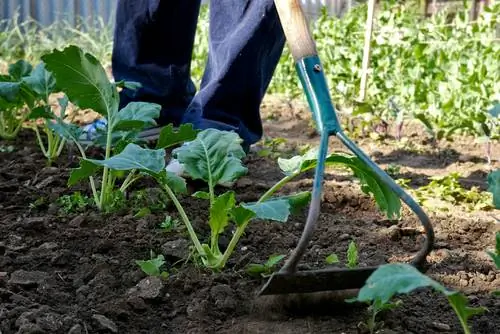
If you chop regularly, you are at risk of flea beetles
The right time
The measures mentioned must be carried out from the end of March / beginning of April and then regularly during the summer months. In the spring you disturb the hibernating adult beetles, and between June and August you prevent the larvae from pupating. However, be careful not to destroy the roots of the plants.
Mixed culture in the vegetable patch
With mixed culture, the gardener plants different types of plants together in a bed instead of filling it with a single variety. The advantage of such a mix is that the different plants strengthen and complement each other - and the entire harvest is not at risk, as is the case with a monoculture. Just as cabbage plants attract cabbage beetles, certain plants - especially onions and garlic - also deter them. Therefore, plant both vegetables near the cruciferous vegetables - but be careful, cabbage vegetables and onions or garlic are not necessarily considered ideal planting partners, as they hinder each other in other respects.
Regular watering with plant manure
Instead of cultivating a mixed culture with cabbage and onions, you can also water the plants with a self-made plant manure. This is a proven and easy-to-produce biological home remedy that, in contrast to chemical sprays, does not show any undesirable side effects. This method not only repels the flea beetles (and other pests and pathogens), but also provides the vegetable plants with fresh, easily accessible nutrients. In addition to onions and garlic, tansy (also known as wormweed), which is often found on roadsides, and wormwood (bitter mugwort) are also suitable for this purpose. You can find all the ingredients either in your own garden or in the great outdoors.
How to make your own plant manure
Making an effective plant manure requires one thing above all: a lot of time. The mixture needs to ferment for at least ten to 14 days, which is why you should let it grow in a warm but dark place in the garden, especially in a secluded place because of the smell. Do not pour the mixture into a metal container, but rather into a plastic or enamel bucket. Use a wooden stick to stir.
Step-by-step instructions for effective plant manure
- freshly harvest one kilogram of suitable plant material
- Crush this carefully and put it in a bucket
- Pour ten liters of fresh water over it
- add a handful of rock dust to create an odor
- Cover the container only with a jute net
- stir daily
The manure is ready when the liquid no longer foams when stirred. Now dilute it with water in a ratio of 1:10 and water your plants with it.
Excursus
Mulch as a less odorous alternative to manure
Unfortunately, the production and use of plant manure is a very odor-intensive affair. Alternatively, you can use onion peels, chopped garlic and shredded tansy to mulch vulnerable vegetable beds. The following video shows this very well using nettle mulch as an example.

What are flea beetles?
Contrary to what their name suggests, flea beetles are not fleas. In fact, behind the misleading name there are different species of leaf beetles (lat. Chrysomelidae). However, the animals, which are only one and a half to three millimeters tiny, have one thing in common with their namesakes: thanks to their strong jumping legs, the adult beetles hop away like fleas when disturbed.
Both the adults and their larvae are phytophagous, as biologist calls herbivores. The insects feast on the leaves of various plant species as well as their roots and therefore cause great damage to both commercial agriculture and home vegetable gardens. While the larvae live underground, the adult beetles are on the surface after pupation and reproduce extremely diligently. This creates several generations each year, which greatly annoy the gardener throughout the entire growing season.
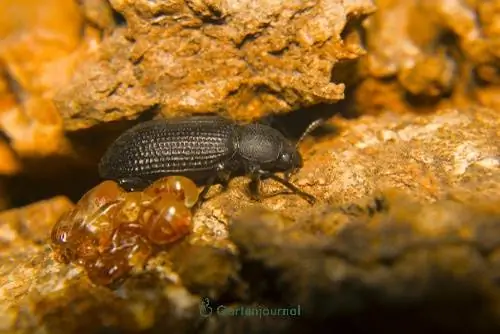
Adult flea beetles eat leaves, the larvae damage the roots
Different species
However, not all flea beetles are the same, as they are a genus comprising around 200 different species. Psylliodes, as the flea beetles are scientifically called, are represented by around 100 species and their subspecies in Europe alone. These usually specialize in certain plant genera and species and can only be found on these. Since they are not a single species, the leaf beetles have a very different appearance. They can be blue-black or bronze-colored, blue, gray, yellow or even striped - the variety of oval, elongated beetles is extremely large.
These three species are particularly difficult for garden owners:
| Flea beetle species | Latin name | Appearance | Preferred plant species |
|---|---|---|---|
| Potato flea beetle | Psylliodes affinis | dark brown shell, yellow vertical stripes | Potatoes, tomatoes and other nightshades |
| Large rapeseed flea beetle | Psylliodes chrysocephalus | shiny, blue-black to dark green shell | Arugula, radishes, radishes, various types of cabbage and other cruciferous vegetables |
| Hop flea | Psylliodes attenuatus | bronze-colored to metallic green shiny shell, yellow-red legs and antennae | Hops, hemp and nettles |
The most common species is the large rapeseed flea beetle, which likes to make itself comfortable in the vegetable patch and find all sorts of delicious food there.
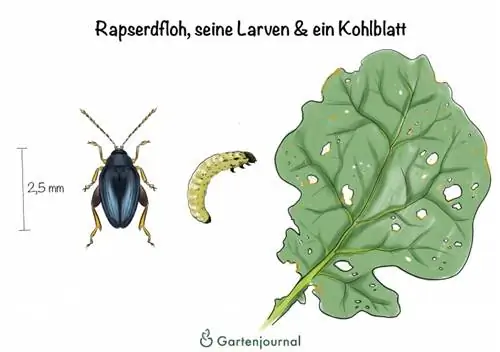
Lifestyle and reproduction
Flea beetles become active with the warm spring temperatures, with the female animals laying their eggs primarily in small holes in the ground on the roots of the preferred plant species, but also on their leaves. The white larvae hatch about ten days after laying their eggs and feed underground on the delicate thread roots of the plants. The damage caused here initially remains invisible, but is not yet too serious. After about three weeks, the larvae pupate in a soil cocoon and finally hatch between June and August. Only the adult beetles cause considerable damage through their feeding activity, which manifests itself as follows:
- Leaf tissue: is scraped off with the mouthparts
- Leaf surface: primarily young plants are destroyed
- Window corrosion: The damaged tissue dries, turns brown and tears
It is less the older, well-established and therefore more robust plants that are at risk, but rather the young plants. Seedlings and seedlings in particular do not yet have enough resistance to assert themselves against a flea beetle infestation and die quickly.
While an infestation on kohlrabi or broccoli does not seem too dramatic - after all, plant parts other than the leaves are eaten here - clearly visible traces of flea beetles on leafy vegetables such as rocket or savoy cabbage are not very appetizing.
Adult flea beetles overwinter in the garden
The adult flea beetles overwinter in the garden and find shelter primarily in the soil, but also in layers of mulch and leaves, under plant residues (including in the compost!), in piles of stones and wood and in hedges. From here, when the temperatures are right, they start their campaign of destruction early in the year and should therefore definitely be combated sustainably.
Excursus
Flea beetles in a flowerpot
The annoying leaf beetles can appear not only in the garden, but also in the greenhouse and even on houseplants. Flea beetles in the house are a particularly annoying problem, as they cannot be combated with the usual means such as hoes and plant manure. Instead, there is an old home remedy that reliably helps: stick a few matches with the sulfur head side down in the flower pot and keep the substrate slightly moist. The leaf beetles cannot tolerate the sulfur-containing material and disappear.
Frequently asked questions
How can I protect my young plants from pests?
He althy, strong plants are usually very well able to defend themselves against pests and pathogens. Strengthen your plants with an adequate supply of nutrients. In particular, spreading compost regularly (and starting early in the year) has proven to be useful and strengthening plants. You should also cover young plants in spring with a close-meshed insect protection net (mesh size 0.8 mm) or garden fleece.
Is it true that flea beetles also avoid spinach and lettuce?
Experience has shown that flea beetles also like to attack lettuce plants, which is why they are not suitable as an avoidance strategy. The animals, on the other hand, actually don't like spinach. Try mulching with chopped spinach leaves - but be careful: snails also like to eat the leafy vegetables. Therefore, a snail fence or another defense strategy makes sense to keep the voracious animals away.
Can't I also fight the flea beetles with insecticides?
In principle, it is of course also possible to get rid of annoying flea beetles with insecticides from specialist retailers. There are some suitable preparations for this, but they all have a serious disadvantage: They not only poison flea beetles, but also other insects and also ensure that your vegetables are also contaminated. Organic-based plant protection products are better, such as the plant protection products already mentioned or neem oil.
Is it true that rye flour helps against flea beetles?
In fact, rye flour is considered an old home remedy for flea beetles and drives them away. To do this, dust the plant completely with the flour; good results can also be achieved with algae lime. However, both only work against the adults and not against their larvae, and powdering can also prevent the plant from photosynthesizing and thus impair growth and development.
Tip
Always wear gardening gloves and long clothing when working in the vegetable patch, as flea beetles like to bite. The bites cause an itchy rash and can be dangerous for allergic people.

